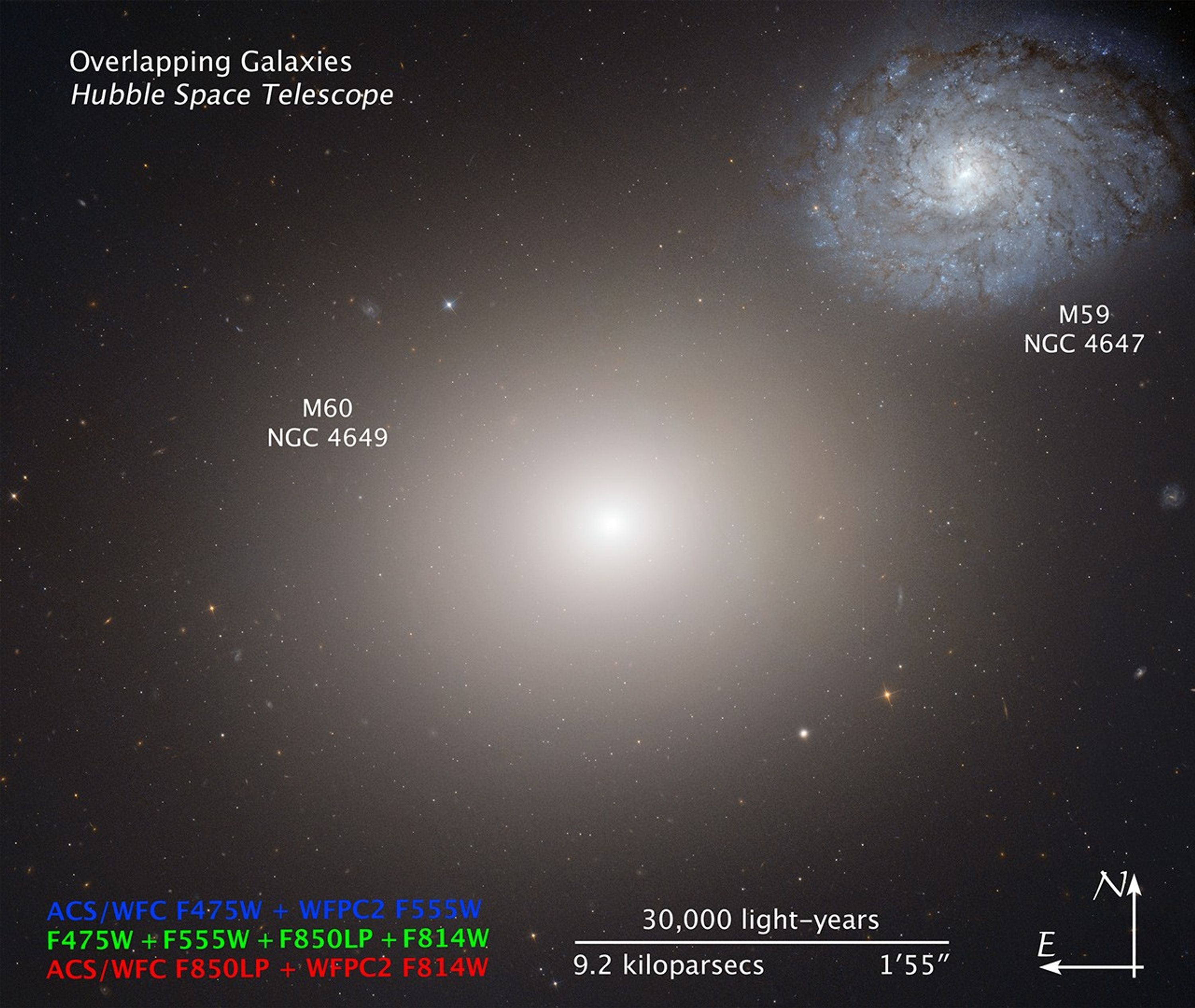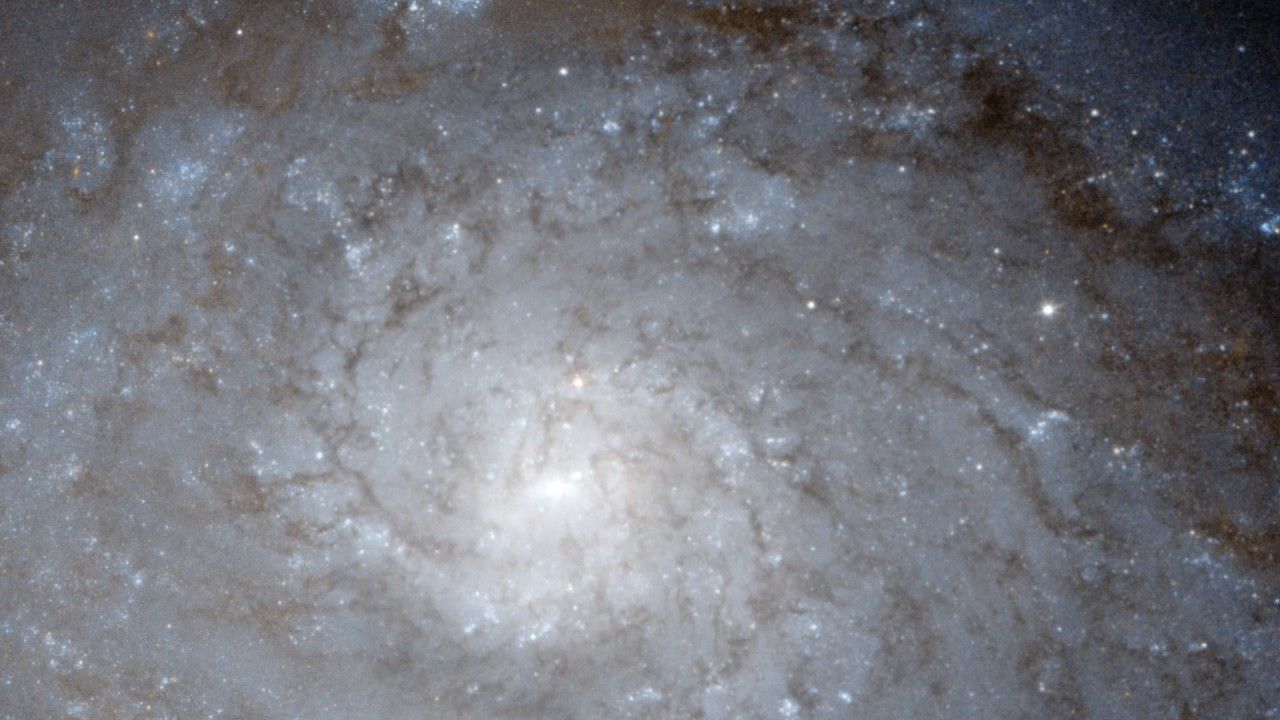1 min read
Odd Galaxy Couple on Space Voyage

Two very different galaxies drift through space together in this image taken by NASA's Hubble Space Telescope. The peculiar galaxy pair is called Arp 116.
Arp 116 is composed of a giant elliptical galaxy known as Messier 60 (or M60) and a much smaller spiral galaxy, NGC 4647.
M60 is the third brightest galaxy in the Virgo cluster of galaxies, a collection of more than 1,300 galaxies. M60 has a diameter of 120,000 light-years, and a mass of about one trillion times that of the Sun. A huge black hole of 4.5 billion solar masses lies at its center, one of the most massive black holes ever found.
The faint bluish spiral galaxy NGC 4647 is about two-thirds of M60 in size and much lower in mass – roughly the size of our galaxy, the Milky Way.
Astronomers have long tried to determine whether these two galaxies are actually interacting. Although looking at them from Earth they overlap, there is no evidence of new star formation, which would be one of the clearest signs that the two galaxies are indeed interacting. However, recent studies of very detailed Hubble images suggest the onset of some tidal interaction between the two.
M60 lies roughly 54 million light-years away from Earth; NGC 4647 is about 63 million light-years away.
This image combines exposures from Hubble's Advanced Camera for Surveys and Wide Field and Planetary Camera 2.
About the Object
- R.A. PositionR.A. PositionRight ascension – analogous to longitude – is one component of an object's position.12h 43m 36s.10
- Dec. PositionDec. PositionDeclination – analogous to latitude – is one component of an object's position.+11° 34' 01''.99
- ConstellationConstellationOne of 88 recognized regions of the celestial sphere in which the object appears.Virgo
- DistanceDistanceThe physical distance from Earth to the astronomical object. Distances within our solar system are usually measured in Astronomical Units (AU). Distances between stars are usually measured in light-years. Interstellar distances can also be measured in parsecs.M60 is roughly 54 million light-years (16 megaparsecs) distant. NGC 4647 is 63 million light-years (19 megaparsecs) distant.
About the Data
- Data DescriptionData DescriptionProposal: A description of the observations, their scientific justification, and the links to the data available in the science archive.
Science Team: The astronomers who planned the observations and analyzed the data. "PI" refers to the Principal Investigator. - InstrumentInstrumentThe science instrument used to produce the data.HST>WFPC2, and HST>ACS/WFC
- FiltersFiltersThe camera filters that were used in the science observations.ACS/WFC: F475W (B) and F850LP (z) WFPC2: F555W (V) and F814W (I)
- Object NameObject NameA name or catalog number that astronomers use to identify an astronomical object.Arp 116
- Object DescriptionObject DescriptionThe type of astronomical object.Elliptical and Spiral Galaxy Pair
- Release DateSeptember 6, 2012
- Science ReleaseOdd Galaxy Couple on Space Voyage
- Credit

The images are composites of separate exposures made by the ACS/WFC and WFPC2 instruments on the Hubble Space Telescope. Four filters were used to sample broad and narrow wavelength ranges for the UVIS image. The colors result from assigning different hues (colors) to each monochromatic image. In this case, the assigned colors are: Blue: ACS/WFC F475W (B) + WFPC2 F555W (V) Red: F850LP (z)+ WFPC2 F814W (I)

Related Images & Videos
Share
Details
Claire Andreoli
NASA’s Goddard Space Flight Center
Greenbelt, Maryland
claire.andreoli@nasa.gov































